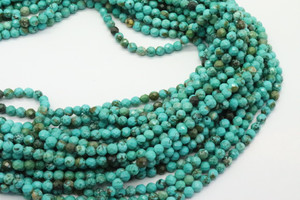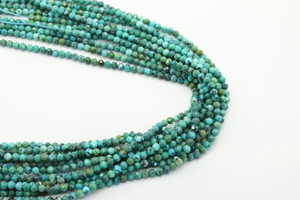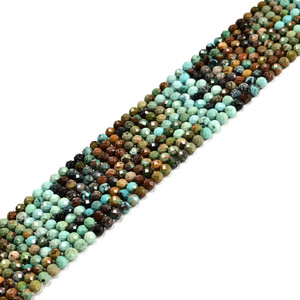
Turquoise, Chinese, Stabilized, Faceted Round, One 2mm Strand
Beauty in the BeadTurquoise, Chinese, Stabilized, Faceted Round, 2mm Strand
This price is for one strand 15 to 16 inches long.
2mm strands have 176 to 181 pieces.
Turquoise is found in only a few places on earth with certain conditions. It must be dry and barren regions where acidic, copper-rich groundwater seeps downward and reacts with minerals that contain phosphorus and aluminum. The result of this sedimentary process is a porous, semi-translucent to opaque compound of hydrated copper and aluminum phosphate. Most of the world's turquoise rough is currently produced in the southwestern United States, China, Chile, Egypt, Iran, and Mexico.
Turquoise is a semi-transparent to opaque stone that ranges in color from whitish blue to deep dark blue, and from deep dark green to a yellowish green. Traditionally, it was said that the most prized turquoise color was a medium robin's egg blue. Vivid shades of turquoise define the color that’s named after this gem.
Turquoise is one of the most fascinating and beautiful gemstones on earth, it is also one of the first gemstones found by man, well over 7,500 years ago. The word turquoise comes from the French for "Turkish", as the gem was originally imported from Turkey. The first recorded use of turquoise as a color name in English was in 1573.
Turquoise is the state gemstone of Arizona, New Mexico and Nevada.
Hardness 5-6
The source of these beads is China and they are cut, drilled and polished in China.
This is a natural stone that has had no treatment other than cutting, drilling, and polishing, and stabilization described below.
Stabilization is the use of adding a colorless bonding agent, commonly plastic or resin into a stone using pressure. It will make the stone more durable, improve appearance and harder so it is unlikely to break or crack. Stabilization can also cause the stone to be no longer porous, so it does not absorb liquids or oils.
The most common material that is stabilized is Turquoise and this process was first invented in the 1950s in Arizona. Only some high-grade natural turquoise is dense enough to be cut and shaped without stabilization. Stabilized Turquoise is better suited for most consumers. It is estimated that over 90-95% of the turquoise on the market today has been stabilized.







